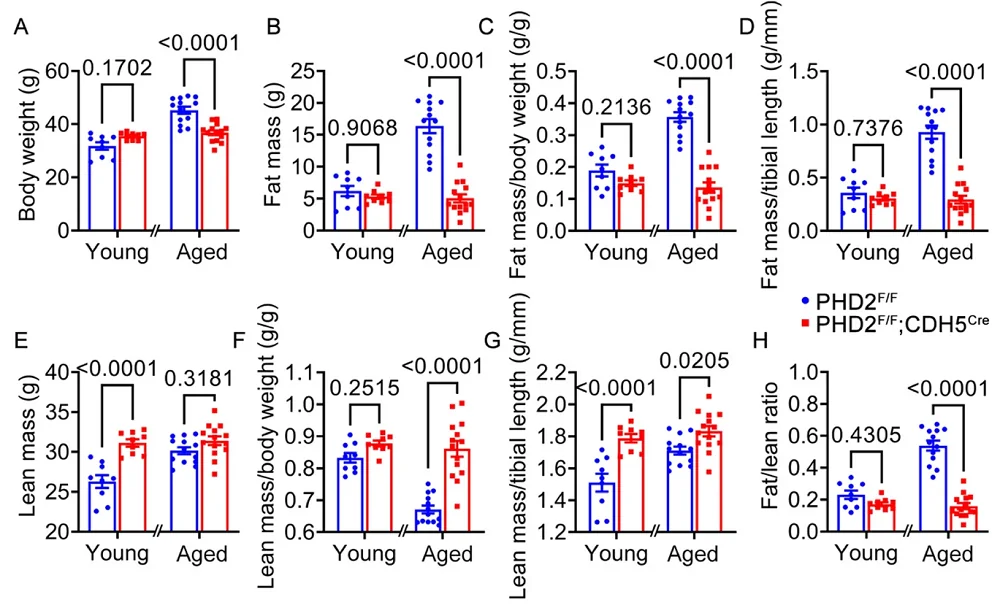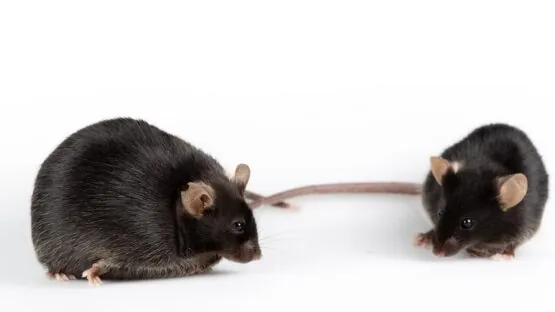In GeroScience, researchers have described how turning off a specific protein prevents mice from getting obese in old age.
Mimicking hypoxia
Hypoxia-inducible factors (HIFs) are a collection of three proteins that are sensitive to oxygen, and, like their name suggests, they normally activate when a cell is operating in a low-oxygen environment. The gene EGLN1 encodes for prolyl hydroxylase domain-containing protein 2 (PHD2), which dampens these factors; accordingly, reducing PHD2 increases their presence [1].
Hypoxia is known to be associated with reduced body weight in both animals [2] and people [3]. The mechanism of action for this has been documented [4] but is not yet fully understood. PHD2 has been linked to diabetes and obesity [5], and an HIF protein has been linked to a reduction in these metabolic disorders [6].
These researchers note that directly manipulating HIF levels in living organisms is challenging and propose that PHD2 is a more readily available target. They created a mouse model that does not express PHD2 in its vascular endothelial cells to test the possible effects of such an approach. Only male mice were used in this study, which the researchers noted as a crucial limitation.
Obesity obliterated, insulin improved
Freely fed mice, eating an entirely normal chow diet, naturally gain weight with aging. However, the PHD2 knockout mice remained statistically unchanged over time, in stark contrast to the control group, in all measurements of body weight, lean mass, and fat mass.

Visually, the mice were completely different, and a dissection showed lean organs in the PHD2-knockout group while their same-age counterparts had substantial fat masses. The PHD2-less mice had less fat on their livers and considerably smaller amounts of white adipose tissue.
Perhaps due to the hypoxia-related proteins, older PHD2-knockout mice breathed more heavily than the control group, particularly at night when mice are most active, and produced more carbon dioxide. However, they did not significantly differ in the amount of food they ate. The researchers, therefore, conclude that the reduction in obesity is more due to an increase in energy use than a reduction in food consumption.
As expected, these leaner aged mice performed better on physical tests than their same-aged counterparts. They were able to run for far longer on treadmills, and their speed was slightly, but not significantly, higher. Aerobic capacity, which declines with aging, did not decline in the PHD2 mice. These performance differences were only in the older mice; younger PHD2-knockout and control group mice had the same levels.
For both younger and older mice, the PHD2-knockout groups were far more able to deal with glucose spikes than the control groups. Baseline blood glucose, which rises with aging, did not rise for the aged PHD2-knockout mice. The PHD2-knockout mice were also much more responsive to insulin.
The cost of PHD2 deletion
However, all of these benefits came with a critical cost: the lifespan of the PHD2 knockout mice was less than of their heavier counterparts, as slightly over a quarter of them had died during the study. The reason for this was not determined in this particular study, but previous studies have found that knocking out PHD2 causes heart enlargement and fibrosis [7] along with severe hypertension [8].
More work needs to be done to determine if PHD2-targeting drugs or other treatments could possibly be used to attenuate or reduce obesity in human beings without causing more heart problems than obesity itself is known to cause.
Literature
[1] Berra, E., Benizri, E., Ginouvès, A., Volmat, V., Roux, D., & Pouysségur, J. (2003). HIF prolyl‐hydroxylase 2 is the key oxygen sensor setting low steady‐state levels of HIF‐1α in normoxia. The EMBO journal.
[2] Simler, N., Grosfeld, A., Peinnequin, A., Guerre-Millo, M., & Bigard, A. X. (2006). Leptin receptor-deficient obese Zucker rats reduce their food intake in response to hypobaric hypoxia. American Journal of Physiology-Endocrinology and Metabolism, 290(3), E591-E597.
[3] Shukla, V., Singh, S. N., Vats, P., Singh, V. K., Singh, S. B., & Banerjee, P. K. (2005). Ghrelin and leptin levels of sojourners and acclimatized lowlanders at high altitude. Nutritional neuroscience, 8(3), 161-165.
[4] Quintero, P., Milagro, F. I., Campión, J., & Martínez, J. A. (2010). Impact of oxygen availability on body weight management. Medical hypotheses, 74(5), 901-907.
[5] Matsuura, H., Ichiki, T., Inoue, E., Nomura, M., Miyazaki, R., Hashimoto, T., … & Sunagawa, K. (2013). Prolyl hydroxylase domain protein 2 plays a critical role in diet-induced obesity and glucose intolerance. Circulation, 127(21), 2078-2087.
[6] Girgis, C. M., Cheng, K., Scott, C. H., & Gunton, J. E. (2012). Novel links between HIFs, type 2 diabetes, and metabolic syndrome. Trends in Endocrinology & Metabolism, 23(8), 372-380.
[7] Dai, Z., Cheng, J., Liu, B., Yi, D., Feng, A., Wang, T., … & Zhao, Y. Y. (2021). Loss of endothelial hypoxia inducible factor‐prolyl hydroxylase 2 induces cardiac hypertrophy and fibrosis. Journal of the American Heart Association, 10(22), e022077.
[8] Dai, Z., Li, M., Wharton, J., Zhu, M. M., & Zhao, Y. Y. (2016). Prolyl-4 hydroxylase 2 (PHD2) deficiency in endothelial cells and hematopoietic cells induces obliterative vascular remodeling and severe pulmonary arterial hypertension in mice and humans through hypoxia-inducible factor-2α. Circulation, 133(24), 2447-2458.




